The photovoltaic industry is back in the "Rasho Gate"
Abstract Recently, the WeChat public account released the article "Photovoltaic, may have been a scam" (the original is attached), saying that China's photovoltaic industry is an industry that can't make money without subsidies, but a low carbon mark. The industry with high energy consumption and high cost is a scene from the beginning...
Recently, the WeChat public account released the "Photovoltaic, may have been a scam" article (the original attached), saying that China's photovoltaic industry is an industry that can not make money without subsidies, a low carbon mark but actually high energy A cost- and high-cost industry has been a scam since the beginning. While the article was heavily reprinted, it also triggered strong opposition from the photovoltaic industry. A number of PV industry insiders said that the article "Scam" has the suspicion of winning the eye. In the analysis of the photovoltaic industry, there are a lot of "may", "may" and other inferences, and the data cited in this article is not in line with reality. Misleading to the reader. Practitioners have called for the photovoltaic industry to require an objective and fair evaluation. An industry source said that PV subsidies are not China's first, but are common practices from developed countries such as Europe and the United States to poor countries in Africa. The low carbon and environmental protection of photovoltaics was not first proposed by China. The article "The Scam" is a reference to the data cited in the European Union in 2012 to prove the high cost of photovoltaics. But in the past four years, the cost of photovoltaic systems has declined geometrically. Historically, component prices have fallen by 21.5% when global PV installations have doubled. “Today, PV EPC costs have dropped to 6 yuan, compared with 10 yuan in 2012, a 40% drop! With the cost reduction, photovoltaic power generation costs are also falling. In another 4 years, PV should be able to achieve Affordable online, no longer rely on government subsidies."
In response, the China Photovoltaic Industry Association issued a document on October 10 and 11 to refute the "scam".
In the article "Analysis of the so-called "high energy consumption" problem in the photovoltaic industry" published on October 10, the industry association pointed out that over the years, due to the backward production equipment of the upstream polysilicon raw materials in the photovoltaic industry, the process technology is incomplete, The production scale is relatively small, the production energy consumption is relatively high, and the industry is also labeled as “high energy consumptionâ€. However, over time, after years of development, the energy consumption of the photovoltaic industry has been greatly reduced.
Recently, the industry association secretariat has used the methods of experts such as Yan Dazhou, deputy secretary-general of the former China Photovoltaic Industry Alliance, to further measure the energy consumption level of the photovoltaic industry chain. It proves that the energy consumed in the manufacturing process of photovoltaic products only requires photovoltaic cells to generate electricity. It can be recovered in the year. In 2015, the energy consumption per 10,000 yuan of output value of the photovoltaic industry was 67% lower than that of the national GDP. This is inconsistent with the wrong view in the article "Scam".
On October 11, the Photovoltaic Industry Association issued the "Strict Statement on Gloen's Untrue Sayings on the Photovoltaic Industry". The article "Scam" said that PV is "high pollution, high energy consumption", "not cheap" and "is backward production capacity". The core viewpoint of "cannot survive without subsidies" has been refuted one by one. (The full text of the statement is attached)
proposition view
The full text of the Photovoltaic Industry Association's "Strict Statement on Gloen's Untrue Remarks on the Photovoltaic Industry":
On September 30th, Gelonghui Technology Development (Shenzhen) Co., Ltd. pushed the article "Photovoltaic, perhaps always a scam" on its WeChat public account "Glonghui". On the basis of the fact that there is no investigation of seeking truth from facts and basically no data and theoretical support, the article only makes subjective judgments, even fabricated by the air, and makes many false statements about China's photovoltaic industry with “maybe†and “possible†methods. The words "scam" and "cheat" have been up to 10 times, deliberately misleading public opinion, causing adverse effects.
As a national-level industry organization officially approved by the Ministry of Civil Affairs, the China Photovoltaic Industry Association believes that it is necessary to represent the Chinese PV industry and seriously point out the erroneous points of the article.
The core arguments of the article "Scam" are as follows: 1. Photovoltaic is a "high pollution, high energy consumption" industry. 2. Photovoltaic power generation is not cheap, and social costs are more expensive. 3. China's PV companies have no incentive to develop new technologies and are backward production capacity. 4. The photovoltaic industry cannot survive without subsidies. These four arguments are all wrong and are simply untenable.
First, is there any high pollution and high energy consumption in photovoltaics?
The original said that photovoltaic is "an industry that is marked by low carbon but is actually high energy consumption and high cost". "The downstream photovoltaic power station seems to be environmentally friendly, but the upstream polysilicon manufacturing is an industry with high energy consumption and high pollution."
According to the estimation of China's photovoltaic industry experts, taking China as an example, the total energy consumption of photovoltaic power generation from raw silicon silica to crystalline silicon photovoltaic power generation system is about 1.52 degrees / watt [1], including silica sand - metallurgical silicon - polysilicon - ingot - Wafer-battery-component production and energy consumption for raw material production, energy consumption for manufacturing, transportation and installation of system components such as steel, cement, cables and inverters required for photovoltaic system construction. The northwestern part of China has abundant solar energy resources. The average utilization time of photovoltaic power generation system is more than 1,500 hours, and the central and eastern part is about 1,100 hours. The average value of the two is 1300 hours. The solar cells per watt can generate about 1.3 a year. degree. From this, it can be concluded that the energy recovery period of photovoltaic power generation is about 1.17 years. From the perspective of the whole life cycle, the power consumed in the production process of solar photovoltaic modules can be fully recovered in just over one year, and the quality of components is generally 25-30 years, which can contribute more than 20 years of clean electricity.
Coincidentally, the latest report of the German Photovoltaic Industry Development Status Report of the German Fraunhofer Institute on April 22, 2016 also pointed out that in Germany, where light conditions are common, photovoltaic power plants can recover PV modules in less than 2 years. Electricity consumed in the production process of the entire industrial chain. After installing each PV module, it can emit at least 10 times more electricity than it is manufactured [2]. It is ridiculous to say that PV is “high energy consumptionâ€.
Second, is photovoltaic power really expensive?
The original said: "Environmental protection of photovoltaic power generation is a false proposition. The social cost of power generation in the photovoltaic industry after considering environmental impact will only be higher."
In June 2016, the International Energy Agency (IEA) published a book entitled “Next Generation Wind Power and Photovoltaics: From Cost to Value†[3], which clearly stated that after the completion of the PV power plant project, the marginal cost of generating electricity is almost zero. . Another IEA report entitled "The Power of Transformation" pointed out that as early as 2013, the cost of photovoltaics and wind power had reached or approached other energy costs based on the "leveling cost" [4].
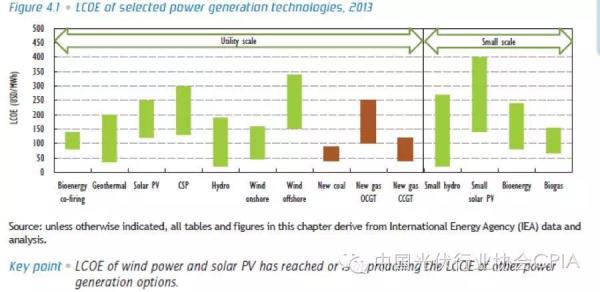
The leveling cost of various types of power generation technology (LCOE) [4], in which the leveling cost of photovoltaics and wind power is very close to other energy sources.
The Fraunhofer Institute for the Development of Photovoltaic Industry in Germany [5] also pointed out that photovoltaic power generation is becoming an ideal alternative energy source for natural gas and coal-fired power plants. The researchers calculated the greenhouse gas emissions of various energy forms based on a large amount of data, saving 1.2 degrees of conventional energy for every 1 degree of electricity generated by photovoltaics. In 2012, the global photovoltaic power generation capacity was about 28 TWh, which is equivalent to reducing carbon dioxide emissions by about 18.6 million tons, making an important contribution to greenhouse gas emission reduction and climate change. 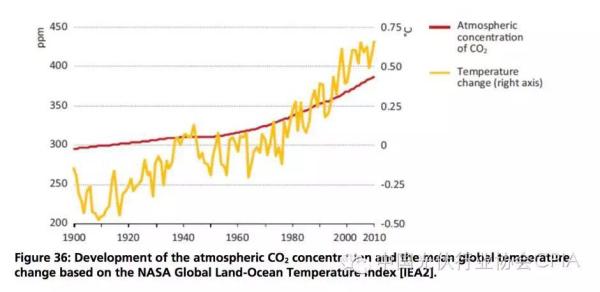
Relationship between atmospheric carbon dioxide content and global average temperature from 1900 to 2010 [5]
3. What is the technology of China's photovoltaics? The original said: "Enterprises have no incentive to develop more efficient technology, and huge subsidies restrict the development of new technologies to some extent." "Photovoltaic power operators ... brush the policy subsidy dividend, for the backward photovoltaic capacity. â€
In recent years, with the joint promotion of internal and external environment, China's photovoltaic enterprises have increased the research and development of process technology, and the level of production technology has continued to improve. China's photovoltaic industry has greatly reduced the price of its products while improving the efficiency of photovoltaic cell modules through technology research and development and industrial production. After 15 years of efforts, the photovoltaic power generation efficiency has increased by 66%, and the photovoltaic power generation cost has been reduced by 90%. The technology of single crystal and polycrystalline battery continued to improve, and the industrialization efficiency reached 19.8% and 18.3%, respectively. The passivation of the emitter back contact, heterojunction, N-type, multiple printing, back electrode and other technical routes accelerated; photovoltaic module packaging And the anti-photo-attenuation technology has been continuously improved, and independent innovation products such as double-sided, double-glass and frameless components have emerged.
Since 2007, PV-Tech, a well-known media in the photovoltaic industry, has tracked R&D investment among many major PV module manufacturers around the world. As shown in the table below, Chinese PV manufacturers are among the best in terms of R&D expenditure, and seven of the twelve are Chinese companies, and R&D investment is increasing year by year.
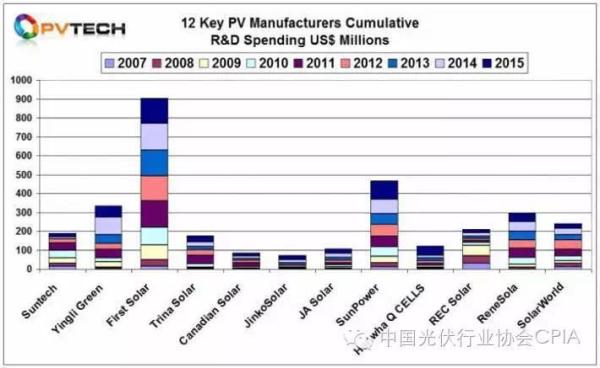
R&D investment of 12 major PV companies in the world from 2007 to 2015
As of 2016, the State Key Laboratory of Photovoltaic Science and Technology, based on Trina Solar, has broken or refreshed the world record of solar cell photoelectric conversion efficiency and component output power for 13 consecutive times [6], and the technological innovations are fruitful. 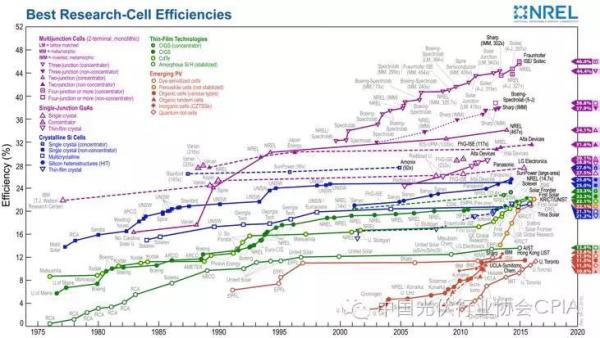
The latest record of solar cell efficiency in the US Renewable Energy Laboratory [6], in which China Trina Solar has repeatedly listed on its own research and development results.
In fact, the original text itself admits: "Most of the world's solar panels are made in China." If there is no innovation drive and innovation leading, how does the “backward†PV capacity in China occupy the global PV market share for a long time? Fourth, is there no subsidy, and photovoltaics will not survive?
The original text said: "The photovoltaic industry is an industry that can't make money without subsidies." "The government has been at the bottom of the hand... slowly let go, this scam story is doomed to stop."
Germany is the first country in the world to subsidize photovoltaic power generation. Supported by industrial policies, Germany has developed rapidly in the case of limited natural light resources. So far, it has achieved a cumulative installed capacity of 40.3GW. Driven by technological advancement and market competition, the German PV price has dropped from 40 Euro cents per degree in 2010 to the current 8 Euro cents per degree, achieving a parity online. Gradually reducing the subsidy policy for declining the slope, providing a huge space for the development of the German photovoltaic industry, promoting energy transformation, optimizing the energy structure, and implementing green development.
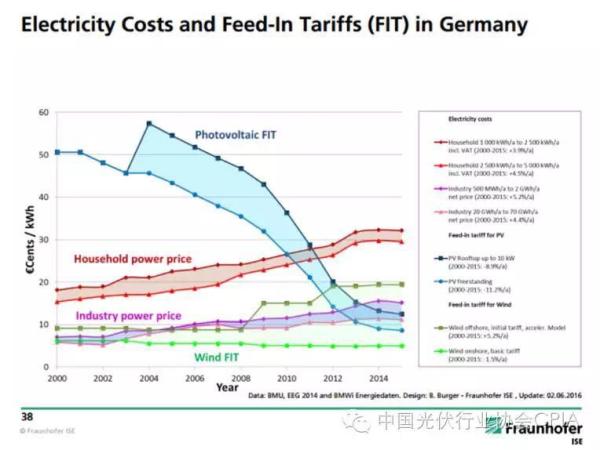
List of German PV price subsidy policies
Bloomberg New Energy Finance (BNEF) stressed in the "2016 New Energy Outlook" [7] that the cost of photovoltaics is going all the way down, and the PV auction prices in many countries are constantly hitting new lows. It is expected that by 2020, most of the world will be Photovoltaic electricity prices will be cheaper than natural gas combined heat and power. In the case of Zhu Yu, a German case, the United States, Japan, India and even African countries have formulated various support policies for photovoltaic power generation in order to achieve an affordable Internet access at an early date and achieve a double harvest of economic and environmental protection. As mentioned above, in the past 15 years, photovoltaic power generation efficiency has increased by 66%, and power generation costs have been reduced by 90%. With the rapid advancement of technology and the sharp drop in cost, the price level of photovoltaic emission is almost in China.
All of these are different.
China's photovoltaic industry started with manufacturing, and driven by innovation to achieve China's leadership, is one of the few physical industries in China that can simultaneously participate in international competition and maintain a leading level. Today, photovoltaic power generation has become the backbone of China's adjustment of energy structure and construction of a green economy. We welcome all sectors of the community to put forward various opinions and suggestions on the development of China's photovoltaic industry, but we will never condone the distortion of facts and malicious acts. For the network rumors, the Association firmly resists.
Here, the China Photovoltaic Industry Association solemnly declares that GLONG Technology Development (Shenzhen) Co., Ltd. and its related media immediately remove the false articles and take necessary measures to eliminate the bad influence.
China Photovoltaic Industry Association will continue to provide comprehensive services to the industry, safeguard the legitimate rights and interests of members and the overall interests of the photovoltaic industry, create a good development environment, and promote the healthy and sustainable development of China's photovoltaic industry.
China Photovoltaic Industry Association
October 10, 2016
October 10, 2016
[1] "Analysis of the so-called "high energy consumption" problem in the photovoltaic industry", China Photovoltaic Industry Association, 2016.10
[2] Fraunhofer Institute for Solar Energy Systems ISE: “Recent Facts about Photovoltaics in Germany†P.42 [3] IEA, Next Generation Wind and Solar Power, 2016, P15: “Once built, wind power and solar PV provide electricity practically for free.â€
[4]IEA, The Power of Transformation, Wind, Sun and the Economics of Flexible Power Systems, P71
[5] Fraunhofer Institute for Solar Energy Systems ISE: “Recent Facts about Photovoltaics in Germanyâ€, P.48-49
[6] National Renewable Energy Laboratory (NREL): http://
[7]Bloomberg: “The New Energy Outlook 2016 Solarâ€, P.5
Counterparty view
Photovoltaic, maybe it’s always a scam
Last night, the National Development and Reform Commission issued the "Notice on Adjusting the New Energy Benchmarking On-grid Price (Consultation Draft)" - if the same sound is sunny, the PV industry practitioners are expected to cry in the toilet.
Compared with previous expectations, the NDRC's price adjustment is even larger. Take the PV on-grid price as an example. The on-grid tariffs of the first-, second- and third-class resource areas of the ground power station are planned to be adjusted to 0.55 yuan, 0.65 yuan and 0.75 yuan, compared with the current electricity price. The standard was reduced by 0.25 yuan, 0.23 yuan and 0.23 yuan respectively. The new policy implementation time is January 1, 2017.
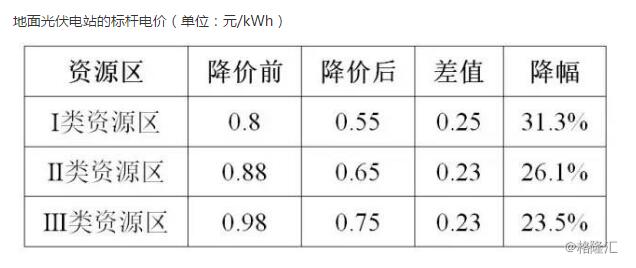
As soon as the news of photovoltaic power prices fell by 31%, all the photovoltaic panels were "monsters" and died.

In May of this year, the National Development and Reform Commission and the Energy Bureau issued the “Management Measures for the Full Guaranteed Acquisition of Renewable Energy Power Generationâ€, which has refined the number of guaranteed acquisition hours in specific regions for both wind power and photovoltaic power plants. According to the latest data, the power curtailment of the North PV power station has been significantly improved. The power cut of a power station in Inner Mongolia has dropped from the highest 40% last year to about 10% today. A power station in Gansu has dropped from 70% to the current 15%. about.
With the continuous decline in the cost of upstream polysilicon, and the green light on the policy, to ensure the photoelectric Internet access, it seems that the hardships of the photovoltaic industry seem to end, but the good days have not been a few days, today ushered in a good start.
However, the real reason for the photovoltaic industry to see the death of light is really only a sharp drop in the price of on-grid and policy instability?
In my opinion, the risk of the photovoltaic industry has long been brewing and fermenting, but it has only been concealed by the hands of industrial policies. The photovoltaics that started with the "low-carbon economy" to create scams are not destined for a long time.
We all know that China's photovoltaic industry has gone through three years of smooth winds in 2009 to 2011. It is also the day when the photovoltaic capacity bubble blows up, but it fell to the bottom after anti-dumping in Europe and America. If the future is not dependent on the NDRC's electricity price subsidy, the days will be even worse. Therefore, the NDRC's electricity price subsidy is only a quick-response to save the heart, and rescue a person who is going to the wood, instead of an operation, even if it hurts, heal it.
The real root of the disease is still from the photovoltaic industry itself. An industry that can't make money without subsidies, an industry that is marked by low carbon but is actually high in energy consumption and high cost, is a scam from the beginning.
The NDRC lowered the price of electricity, only to recognize and correct the romantic mistakes of many years ago.
Second, the low carbon economy scam
The “hot†of the photovoltaic industry began in 2009. Why was it not hot late or late, but it became popular after the financial crisis? Was it the wind at the time? Also popular in 2009 is Copenhagen's Global Climate Summit, where carbon dioxide causes global warming and may eventually lead to the destruction of the planet, with a focus on reducing carbon emissions.
As an outstanding representative of the low-carbon economy, the photovoltaic industry came into being at such a time.
For ZF, we will hand in the industry and provide subsidies to create a “high-minded and far-sighted†performance that “supports clean new energyâ€. For enterprises, there is ZF subsidy, and even can be cheated, there is almost no risk of “failureâ€.
The two need each to achieve a perfect tacit understanding: the photovoltaic industry has become a violent movement of up and down resonance, and even forged the richest man in China.
But in reality, photovoltaics are neither as low-carbon as we think, so clean, and there is no so-called low-cost advantage. The downstream PV power generation seems to be environmentally friendly, but the upstream polysilicon manufacturing is an unavoidable high-energy, high-pollution industry. In the entire polysilicon production process, a large amount of water, energy, and atmospheric emissions, even if technically. There is a relatively environmentally friendly route, but do you think that this kind of local taxpayer has had the opinion of the Environmental Protection Agency in the early years? A lot of things, not only to see the standards on the board, but also to see the final implementation. On the whole, the environmental protection of photovoltaic power generation is a false proposition. The social cost of power generation in the photovoltaic industry after considering the environmental impact will only be higher.
According to the EU report, the estimation of the cost of various forms of power generation shows that renewable energy generation, especially wind power generation, is certainly more cost-effective than coal power generation if environmental costs are considered.
Surprisingly, however, solar power is much more expensive than wind power than hydropower – at least in the EU.
The report also assesses the cost of electricity generation and the environmental impact of power generation. They use a measurement called “leveling cost†to estimate the cost per megawatt hour of a power plant in a given area during the production period, regardless of ZF subsidies, and assume The cost of emitting one ton of carbon dioxide is 43 euros ($55).
Surprisingly, analysis shows that solar power costs are the highest, much higher than wind power. The report believes that the reason is that most of the world's solar panels are made in China, and China's electricity is a coal-intensive industry. The consumption of metal resources also makes solar power generation cost higher than wind power.
According to the analysis of the report, the leveling cost per MWh of the new coal and natural gas plants in the EU is only over 50 euros ($64) (assuming the plant operates at its maximum capacity) (2012 data); per megawatt of offshore wind power The watt-hour standardization cost is about 80 euros ($102); nuclear power generation is about 90 euros ($115); solar photovoltaic power generation is about 100 euros ($127); hydroelectric power generation is as low as 10 euros.
It turns out that photovoltaic power generation is not only cheap, but the social cost is still very expensive. Once ZF subsidies are reduced, there is no NDRC to give it a bottom. It simply cannot afford to realize commercial profitability. The story of “clean new energy†is actually a self-deception scam from the beginning.
After the global oil price fell sharply, this scam was finally unable to go round.
Third, the fate of the abandoned light limit
Both photovoltaic power generation and wind power generation have the same obvious shortcomings, are susceptible to weather, and are unstable in power generation, making it difficult to replace thermal power generation and nuclear power on a large scale. In other words, photovoltaic power generation is an industry that looks at the sky. There are many weather phenomena affecting photovoltaic power stations. Thunderstorms, hail, sandstorms, sand, dust, snow, etc., there is a weather phenomenon, which determines that there is no food for this day.
The unstable characteristics of photovoltaic power generation are very unfavorable for grid interconnection. Since the power generated by the photovoltaic system is constantly changing due to the influence of the environment, it is not a stable power source. The power grid management unit has limited peaking capability and is not willing to accept the grid access of the photovoltaic system. When the peak cannot be smoothly adjusted, photovoltaic power generation will be “discarded and limitedâ€. For example, last year, the national average light rejection rate reached 14%, and the highest rate in Gansu Province reached 40.2%.
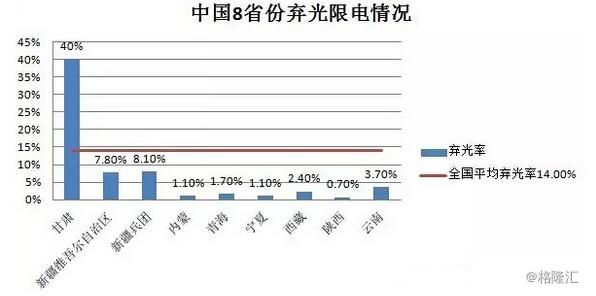
In the past few years, for photovoltaic power generation operators, the best strategy is to do everything possible to get the road, quickly build a station to do large-scale, brush the policy subsidy dividend, for the backward photovoltaic capacity to continue, lying By brushing profits, companies naturally have no incentive to develop more efficient technologies. The huge subsidies restrict the development of new technologies to some extent. Because the policy dividend is too tempting, a large amount of social capital floods into photovoltaic power generation, resulting in inefficient projects for non-professionals to operate, and so on, after the tide has faded, will not know where to go.
When the New Deal comes out today, it can be foreseen that before the big limit of July 1 next year, there will inevitably be another wave of rushing...
Conclusion:
The industry of photovoltaics, at the beginning of the fire, is aimed at reducing long-term costs, low-carbon economy, energy saving and environmental protection. Unexpectedly, however, considering the environmental costs, solar power generation is much more expensive than hydropower than wind power, because although the power generation process consumes less energy, the process of making solar panels is energy intensive. Moreover, the crystalline silicon industry does not have the molar effect of the electronics industry, and the conversion rate and power generation efficiency are far from being imagined.
Therefore, we must admit that the photovoltaic word order is a scam at the beginning. It is a scam that everyone can selectively believe, and it is destined to not last long. ZF has been at the bottom of the hand has been more than enough, and with the slow release of this hand, this scam story is doomed to stop.
After the blessings of the blessings and subsidies, when the hardships of the industry come, the elimination of a number of policy arbitrageurs will force the industry giants to increase investment in research and development, break through technological bottlenecks, increase photoelectric conversion rate, and control upstream manufacturing pollution. To reduce the cost of photovoltaic power generation and use the market hand to screen out real low-cost companies. At that time, it may be the real industry spring.
Stainless Steel Bathroom Accessories
Stainless steel Bathroom Accessories are becoming more popular with the improvement of the production process.
Stainless steel construction prevents rust and corrosion in your bathroom for long lasting durability.
Stainless steel bathroom accessories has a variety of colors. Color options have chrome, black, matt black, white, matt white, nickel brushed, gold, rose gold, gun mental etc.
Different styles can satisfied with all your requirement. Pls feel free to contact us for further info.
Stainless Steel Bathroom Accessories,Stainless Steel Bathroom Fittings,Stainless Bathroom Accessories,Luxury Stainless Steel Bathroom Accessories
Kecheng Trading Company Limited , https://www.jmttl.com
